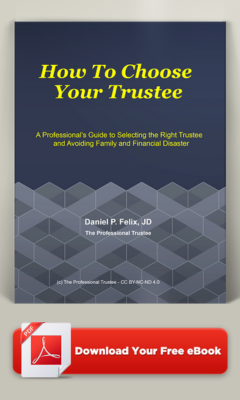Hartley Goldstone and Kathy Wiseman initiated the Positive Story Project to educate through instances where the relationship between trustees, beneficiaries, and their advisors have worked out well. Goldstone and Wiseman collected these true stories— and contributed from their own experience. Their sharing and publishing included their book entitled: “TrustWorthy: New Angles on Trusts from Beneficiaries and Trustees: A Positive Story Project showcasing beneficiaries and trustees.”
The following was my contribution to the Positive Story Project, and published in “Trustworthy” pretty much as it appears here.
This story is about brother and a sister as they age. It is about a trustee who believes that considering the human needs, not just the financial ones, is very important. The lead character is the grantor, Bernard, who has no children but is very close to his sibling, Felicia, and her children. I am the trustee of his trust.
The story begins when Felicia is being cared for in her home. Not legally competent, Bernard lives in a facility. He was settled and well-cared for.
However, it wasn’t easy for either to travel to see the other— and so, visiting— and any communication for that matter— just didn’t happen.
The family’s difficult decision to move Felicia to an assisted living facility prompted me to think about Bernard moving to the same place. Until I started on that path, there was no mention of joining the two of them from the family or any of the health care or other professionals.
Learning how important Bernard and Felicia were to one another took investigation and questions, but that is what I believe my role to be. My role as a trustee is about getting deeply involved. This approach improved the quality of both of their lives.
I talked to Bernard as well as his several of his family members, which included his guardian and the holder of the power of attorney for property— both of whom are caring, interested and involved. Not only are his family members an important part of Bernard’s support system, but they are also contingent beneficiaries with interests in Bernard’s estate.
It soon became apparent to me that there was a gap, a missing piece that would make life better for Bernard, involving his wonderful relationship with his sister. In our conversations, they detailed Bernard’s family orientation and his love for his sister. They also confirmed their own desire to re-unite the two.
The trust gave me the discretion to do things that benefit Bernard. I came to believe that one of the things important in administering this trust was reconnecting the siblings. Because they are so fond of each other and enjoy the time that they spend together, I was eager to solve the problem of separate living arrangements.
It was clear to me that this had to be accomplished.
While reuniting a brother and sister may not seem legally relevant, it meant a lot to my charge, Bernard. As it happens, the decision to move Bernard was made easier because the new living arrangement was less expensive for Bernard. Had it been a more difficult situation, I might have gotten some formalized consent from the other stakeholders.
Once under the same roof, Bernard saw Felicia every day, as compared to not seeing her. It is such a thrilling resolution. They were reunited and happy to be with each other.
How does it happen that a trustee considers more than money? I think that it is important look at a beneficiary’s true best interests in the context of their family system.
Routinely, when doing due diligence before accepting appointment as trustee, I meet with all the players involved— beneficiaries, family members, guardians, caregivers. I’m joining a team and have to know them well. I am careful about getting involved and I want a high confidence level that we as a team can deal with issues that come up later. I look to see how open and awake the key people are.
The trustee role is about being aware of the different needs of the beneficiaries, including serving their families when that benefits the beneficiary. In the best situation, the trustee knows how to deal practically, powerfully, and proactively within the four corners of the trust document and the law.
Photo by Patty Brito on Unsplash© 2011 – 2023 Daniel P. Felix, all rights reserved.


